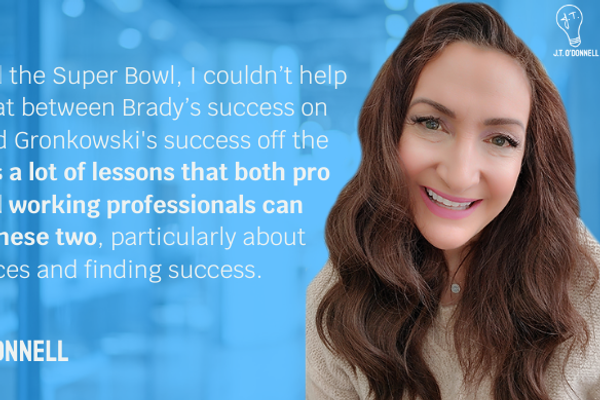
If you're wondering how you're going to get where you want to be in your career, there are some simple steps you can take that will help you create your own career development plan.
Let's not be confused by the word “simple." Sometimes the simplest of concepts or steps can be tough to do because they require some intense thinking and effort. Yet, your think time and effort are an investment in your future and career happiness, which make it all very worthwhile to plan your career growth today.
1. Figure Out Your Destination
As with all efforts, you must be clear about your direction when you create your own career development plan. You don't take a road trip without knowing where you want to end up. You also don't need to overly complicate this task. I think the following questions are helpful in thinking about your destination.
Where do you want your career to be in two years?
I like this question because this window is close enough to your current reality that it's easy to visualize.
Where do you want your career to be in five years?
If you see that your two-year goal is merely a step in an overall direction, then this question helps you define a longer-term career growth goal. Sometimes it's difficult to see that far out in time as life and different opportunities present themselves and can cause you to reset your plans. That's okay, but it's good to be looking "two steps ahead."
What makes these targets resonant for you?
Don't make a goal just for the sake of making one. You need a goal that helps to motivate you into action. If you're making a goal based on what someone else wants, it also isn't going to be that compelling for you. Being clear on your direction means being clear that this direction is inspiring and motivational, and knowing what is driving you to it.
2. Do A Gap Analysis

Bigstock
A gap analysis is where you figure out the differences in the qualifications between where you are right now and your two-year goal or next step. Using a job posting or job description for the position you are aiming at is a good way to get specific information about the skills and experience that are expected. I think it is good to get more than one job description (perhaps one from your company and one from a competitor) in order to ensure you aren't missing any key items during your analysis.
Go through the job description line item by line item and rate your current state of skills, education, or experience to what is listed. Your rating system can be as simple as 1-10, with 10 a perfect match and one being completely missing. As you rate, make notes about your thought process for future reference.
Once you have completed this exercise, identify all of the items where there is anywhere from a fair amount to a substantial amount of development that is needed. Look for commonalities and clump those together as a category. You will discover that there will be themes to your gaps.
Also, don't get too compulsive about where you don't think you're a perfect match but think you have fairly developed skills. If they are mostly present, they will make you a competitive candidate and shouldn't require too much development attention. You now have a list of development items.
3. Create Your Development Plan
 Bigstock
BigstockYou are now fully armed with a clear two-year goal and all the details of where and what you need to develop to get you where you want to go. Your plan will be best if you can consult with your boss and/or a mentor to help you with ideas on how to get the skills you need to add.
There may need to be some logical order to a few of the items on your list. Sometimes you need to do X before you can do Y. Make these among the highest priority items so you can accomplish these things and move on to others. Usually, there are multiple ways of accumulating the skills you need for career growth.
You may also want to have multiple ways of beefing up your skill set to add depth to it. An example is if you want to move to a project management position, you may want to get a certification and also ask for project responsibilities. Initially, these may be small, which is fine; they will give you an opportunity to grow and learn. In addition, you may need to research various ways to get the skills you need to grow in your career.
Once your research is done, it will give you ideas on how you can approach these items. You need dates. You need to keep yourself accountable to your plan. And the best way to do that is to give yourself a "start by" date.
You can't predict how long or how much work you will have to do in order to develop the skill at the level you need, but you do have control over the action you take to get started. Keep track. You need to pay attention to your career development plan a minimum of twice per year. This will allow you to stay focused on your progress and remind you of next steps.
Career development is the sort of thing that you can easily forget about until you wake up one day to realize you have gone nowhere and aren't having fun. You are responsible for where you go in your career. With a little bit of planning, you can accomplish great things.
Need more help with your career?
We'd love it if you signed up for Work It Daily's Power Hour Event Subscription! Get your career questions answered in our next live event!
This article was originally published at an earlier date.
- 5 Professional Development Tips To Up Your Career Game - Work It Daily | Where Careers Go To Grow ›
- 5 Tips For Reclaiming Your Career & Finding Happiness - Work It Daily | Where Careers Go To Grow ›
- JT Talks Jobs - 2 Tests For Planning Your Next Career Move - Work It Daily | Where Careers Go To Grow ›
- How To Manage Up In Your Job - Work It Daily | Where Careers Go To Grow ›
- 3 Benefits Of Having A Career Plan - Work It Daily | Where Careers Go To Grow ›
- 10 Things You Can Do To Improve Your Career Today - Work It Daily | Where Careers Go To Grow ›
- 4 Reasons To Set Aside Time For Career Planning - Work It Daily ›
- 4 Reasons To Take Online Career Courses - Work It Daily ›
- Career Management: Defining The Process And Purpose - Work It Daily ›
- Why Failure Is Important For Success - Work It Daily ›
- 3 Career Myths That Couldn't Be Further From The Truth - Work It Daily ›
- 5 Things To Know Before You Become A Career Coach - Work It Daily ›
- 4 Words Impacting Your Career Growth - Work It Daily ›
- The Process Of Career Management - Work It Daily ›
- The Best Tips For Team Goal Setting & Business Planning - Work It Daily ›
- How To Create A Job Description That Sparks Interest - Work It Daily ›
- Do You Know The 4 Words That Could RUIN Your Career? - Work It Daily ›

 Bigstock
Bigstock Bigstock
Bigstock Bigstock
Bigstock


